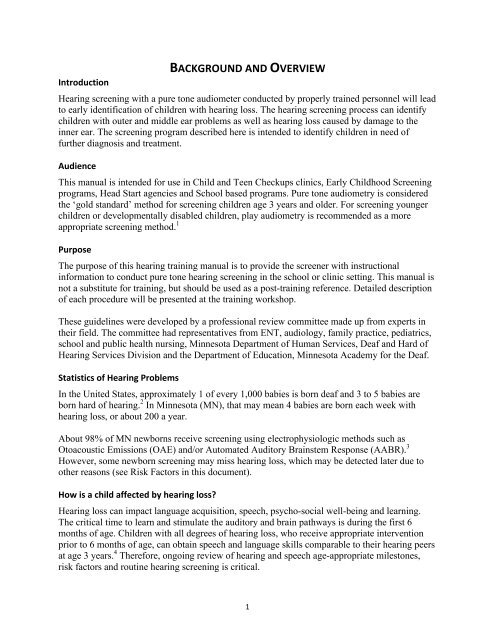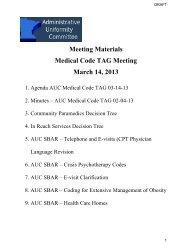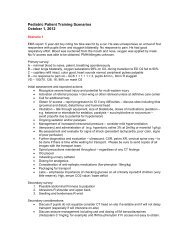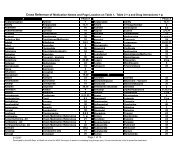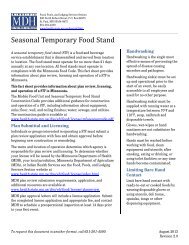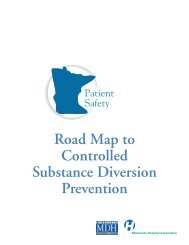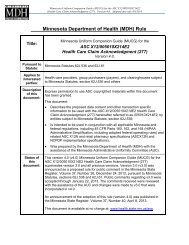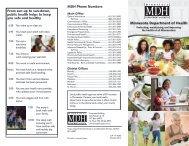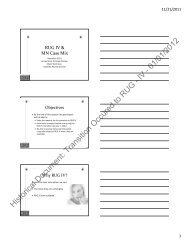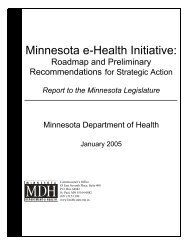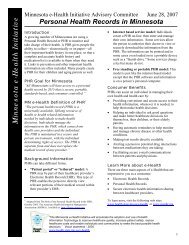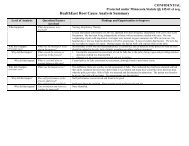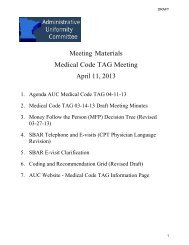Hearing Screening Training Manual - Minnesota Department of Health
Hearing Screening Training Manual - Minnesota Department of Health
Hearing Screening Training Manual - Minnesota Department of Health
You also want an ePaper? Increase the reach of your titles
YUMPU automatically turns print PDFs into web optimized ePapers that Google loves.
Introduction<br />
BACKGROUND AND OVERVIEW<br />
<strong>Hearing</strong> screening with a pure tone audiometer conducted by properly trained personnel will lead<br />
to early identification <strong>of</strong> children with hearing loss. The hearing screening process can identify<br />
children with outer and middle ear problems as well as hearing loss caused by damage to the<br />
inner ear. The screening program described here is intended to identify children in need <strong>of</strong><br />
further diagnosis and treatment.<br />
Audience<br />
This manual is intended for use in Child and Teen Checkups clinics, Early Childhood <strong>Screening</strong><br />
programs, Head Start agencies and School based programs. Pure tone audiometry is considered<br />
the ‘gold standard’ method for screening children age 3 years and older. For screening younger<br />
children or developmentally disabled children, play audiometry is recommended as a more<br />
appropriate screening method. 1<br />
Purpose<br />
The purpose <strong>of</strong> this hearing training manual is to provide the screener with instructional<br />
information to conduct pure tone hearing screening in the school or clinic setting. This manual is<br />
not a substitute for training, but should be used as a post-training reference. Detailed description<br />
<strong>of</strong> each procedure will be presented at the training workshop.<br />
These guidelines were developed by a pr<strong>of</strong>essional review committee made up from experts in<br />
their field. The committee had representatives from ENT, audiology, family practice, pediatrics,<br />
school and public health nursing, <strong>Minnesota</strong> <strong>Department</strong> <strong>of</strong> Human Services, Deaf and Hard <strong>of</strong><br />
<strong>Hearing</strong> Services Division and the <strong>Department</strong> <strong>of</strong> Education, <strong>Minnesota</strong> Academy for the Deaf.<br />
Statistics <strong>of</strong> <strong>Hearing</strong> Problems<br />
In the United States, approximately 1 <strong>of</strong> every 1,000 babies is born deaf and 3 to 5 babies are<br />
born hard <strong>of</strong> hearing. 2 In <strong>Minnesota</strong> (MN), that may mean 4 babies are born each week with<br />
hearing loss, or about 200 a year.<br />
About 98% <strong>of</strong> MN newborns receive screening using electrophysiologic methods such as<br />
Otoacoustic Emissions (OAE) and/or Automated Auditory Brainstem Response (AABR). 3<br />
However, some newborn screening may miss hearing loss, which may be detected later due to<br />
other reasons (see Risk Factors in this document).<br />
How is a child affected by hearing loss?<br />
<strong>Hearing</strong> loss can impact language acquisition, speech, psycho-social well-being and learning.<br />
The critical time to learn and stimulate the auditory and brain pathways is during the first 6<br />
months <strong>of</strong> age. Children with all degrees <strong>of</strong> hearing loss, who receive appropriate intervention<br />
prior to 6 months <strong>of</strong> age, can obtain speech and language skills comparable to their hearing peers<br />
at age 3 years. 4 Therefore, ongoing review <strong>of</strong> hearing and speech age-appropriate milestones,<br />
risk factors and routine hearing screening is critical.<br />
1


